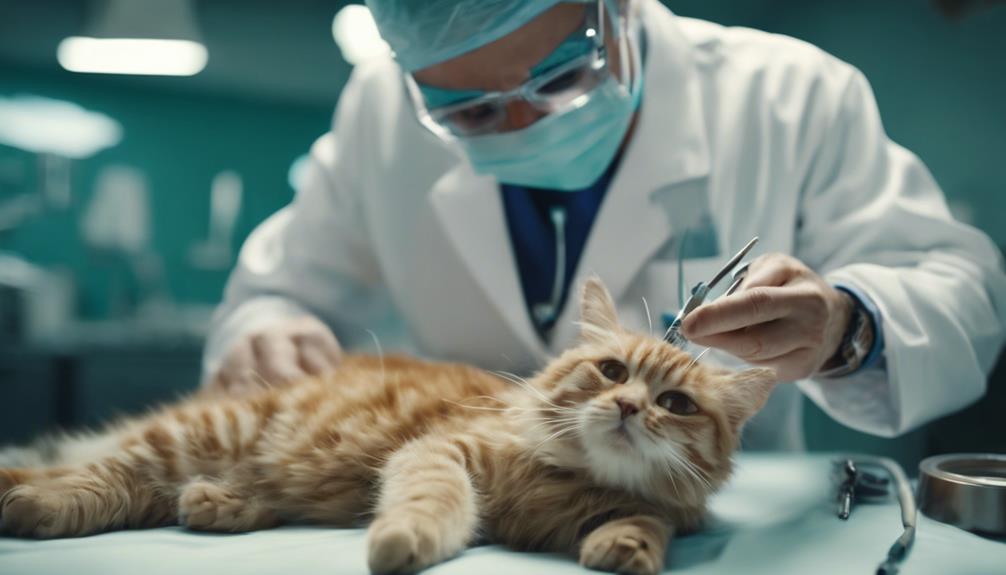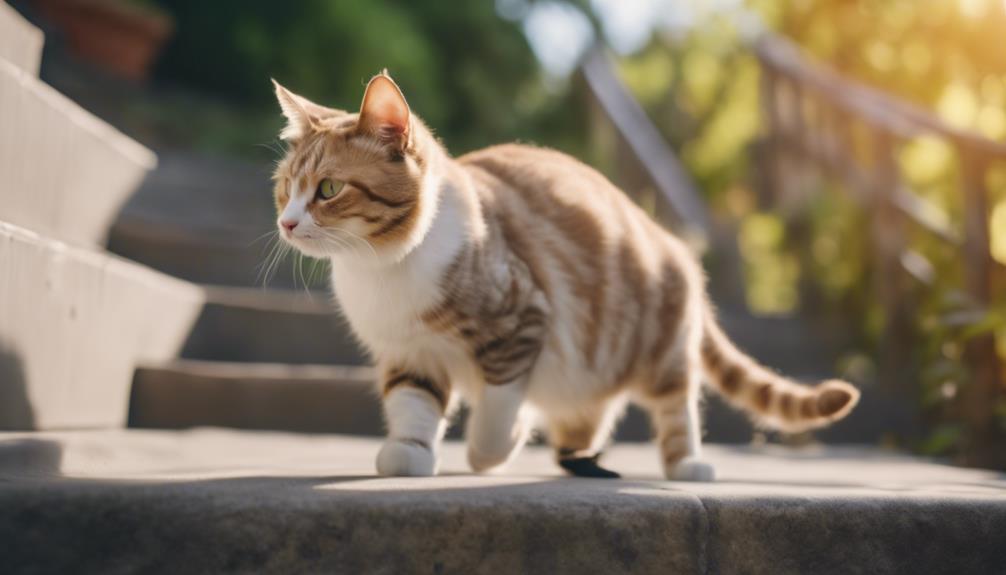Hip dysplasia in cats is a complex orthopedic issue that warrants careful consideration due to its impact on our feline companions. From subtle signs that might go unnoticed to the challenges it poses for treatment, this condition requires a nuanced approach for effective management.
By exploring the various facets of this condition, we can better equip ourselves to support our cats' musculoskeletal health. Understanding the signs, treatment options, and prevention strategies is key to ensuring the well-being of our four-legged friends.
Key Takeaways
- Hip dysplasia in cats is primarily caused by genetics and can lead to arthritis.
- Signs include difficulty moving, reluctance to use the litter box, and excessive licking.
- Treatment involves weight management, supplements, ramps, and surgical options for severe cases.
- Prevention includes limiting jumping for kittens, maintaining a healthy weight, and regular vet check-ups.
Understanding Hip Dysplasia in Cats
What is the underlying cause of hip dysplasia in cats, a condition characterized by a malformation of the ball and socket joint of the hip?
Hip dysplasia in cats primarily stems from genetics, leading to joint laxity and subsequent arthritis. The malformation of the hip joint can result in pain, lameness, and reduced mobility in affected felines.
While genetics play a significant role, trauma can also contribute to the development of hip arthritis in cats. Understanding the genetic predisposition to hip dysplasia and the impact of potential traumas can aid in the prevention and management of this condition.
Signs and Symptoms of Cat Hip Dysplasia
Signs indicative of cat hip dysplasia encompass observable changes in a feline's mobility and behavior. Cats affected by hip dysplasia may exhibit the following signs and symptoms:
- Difficulty jumping or walking
- Limping
- Avoiding physical activity
- Excessive licking or chewing of the affected area
- Reluctance to use the litter box
It's essential to be vigilant for these signs as cats are known to hide their pain well, making diagnosis challenging. If you notice any of these symptoms in your cat, consulting with a veterinarian for a proper diagnosis and treatment plan is recommended.
Treatment of Hip Dysplasia in Cats

Cats diagnosed with hip dysplasia often require a comprehensive treatment plan aimed at managing their condition and improving their quality of life. Treatment involves various strategies to alleviate discomfort and improve mobility. This may include maintaining a healthy weight through diet and exercise, providing aids like ramps or steps for easier movement, and incorporating joint supplements containing glucosamine or chondroitin. Additionally, alternative therapies such as acupuncture or physical therapy can be beneficial in managing hip dysplasia in cats.
| Treatment Strategies | Description |
|---|---|
| Maintain Healthy Weight | Helps reduce stress on the affected joints and minimizes discomfort. |
| Provide Assistive Aids | Ramps or steps can facilitate easier access to elevated surfaces for cats with mobility issues. |
| Joint Supplements | Supplements containing glucosamine or chondroitin can support joint health and reduce inflammation. |
| Consider Alternative Therapies | Acupuncture or physical therapy may aid in managing pain and improving mobility. |
| Regular Vet Check-ups | Ensuring routine veterinary visits for monitoring and adjusting the treatment plan as needed. |
Surgical Treatment of Hip Dysplasia in Cats
Surgical interventions play a crucial role in addressing severe cases of hip dysplasia in cats, offering effective solutions to enhance their quality of life and mobility. One common surgical option for severe hip dysplasia in cats is femoral head and neck excision, where the head of the femur is removed. This procedure can cost between $1,500 to $3,000 and aims to alleviate pain and improve mobility. After surgery, cats typically form a false joint at the hip, allowing them to regain function and mobility. However, hip replacements are rare in cats due to bone size constraints. It is important to consult with a veterinarian to determine the best surgical approach for each individual cat.
- Femoral head and neck excision is a common surgical option.
- Cost of surgery typically ranges from $1,500 to $3,000.
- Cats form a false joint post-surgery.
- Hip replacements are rare due to bone size constraints.
- Consult with a veterinarian for the best surgical approach.
Prevention of Hip Dysplasia in Cats

To mitigate the risk of hip dysplasia in cats, proactive measures focused on promoting joint health and minimizing strain on the hip joints are crucial. Limiting activities that put excessive stress on the hips, such as jumping from high surfaces, is advisable, especially for kittens until they are fully grown.
Maintaining a healthy weight through a balanced diet and providing opportunities for moderate exercise can also help prevent the development of hip dysplasia. Regular veterinary check-ups that include joint health assessments are essential in catching any potential issues early.
Additionally, seeking out reputable breeders who conduct Orthopedic Foundation for Animals (OFA) hip screenings before breeding can aid in reducing the genetic predisposition for hip dysplasia in cats.
Frequently Asked Questions
Can Hip Dysplasia in Cats Be Prevented Through Specific Breeding Practices?
Preventing hip dysplasia in cats through selective breeding practices can be effective. Screening breeding cats for hip dysplasia and opting for those with healthy hips can reduce the risk of passing on this condition to their offspring, promoting feline joint health.
Are There Any Alternative Therapies or Home Remedies That Can Help Manage Hip Dysplasia in Cats?
Alternative therapies such as acupuncture, physical therapy, and joint supplements like glucosamine can help manage hip dysplasia in cats. Home remedies like providing ramps, steps, and maintaining a healthy weight through diet and exercise are beneficial.
How Common Is Hip Dysplasia in Cats Compared to Other Joint Issues?
Hip dysplasia in cats is less common compared to other joint issues. It primarily results from genetics or trauma, leading to arthritis. Proper diagnosis can be challenging due to cats hiding pain. Prevention includes monitoring weight, limiting jumping, and regular joint health checks.
Are There Any Specific Dietary Recommendations for Cats With Hip Dysplasia?
For cats with hip dysplasia, dietary recommendations include maintaining a healthy weight through balanced nutrition to reduce joint stress. Incorporating joint supplements like glucosamine and chondroitin can support joint health. Consult a veterinarian for tailored advice.
Can Physical Therapy or Rehabilitation Exercises Be Beneficial for Cats With Hip Dysplasia?
Physical therapy and rehabilitation exercises can be beneficial for cats with hip dysplasia by improving joint flexibility, strength, and mobility. These interventions can help alleviate pain, enhance quality of life, and promote overall well-being in feline patients.
Can Hip Dysplasia Affect a Kitten’s Growth and Development?
Hip dysplasia can indeed affect a kitten’s growth and development. This condition, commonly seen in larger breeds, occurs when the hip joint doesn’t develop properly. It can lead to pain, mobility issues, and even lameness. Understanding kittens growth stages explained is crucial to spotting any abnormalities early on and seeking appropriate veterinary care to ensure healthy development.
Conclusion
In conclusion, hip dysplasia in cats is a complex orthopedic condition that can have significant implications for feline health and well-being.
Recognizing the signs and symptoms, exploring treatment options, and implementing preventive measures are essential components in managing this condition effectively.
By staying informed and proactive, cat owners and veterinarians can work together to provide the best possible care for cats affected by hip dysplasia.




